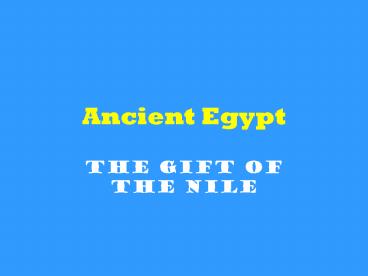Ancient Egypt - PowerPoint PPT Presentation
1 / 25
Title:
Ancient Egypt
Description:
Ancient Egypt The gift of the Nile Extremely important to development of Egyptian civilization Yearly floods soaked the land with water and deposited silt ... – PowerPoint PPT presentation
Number of Views:138
Avg rating:3.0/5.0
Title: Ancient Egypt
1
Ancient Egypt
- The gift of the Nile
2
Nile River
- Extremely important to development of Egyptian
civilization - Yearly floods soaked the land with water and
deposited silt (soil). - The most fertile land was where the Nile empties
into the Mediterranean, the delta. - Flows from south to northUpper Egypt is south
and Lower Egypt is north. - Egypt had natural barriers the desert and
cataracts, which made the river impassable. So
Egypt couldnt be invaded from the south.
3
The Nile
4
History
- Two kingdoms Lower and Upper, with different
customs and dialects. - Menes is the king who unites Upper and Lower
Egypt, in 3100 BC.
5
Old Kingdom (2650 BC to 2150 BC)
- --Ruled by pharaohs, Egyptian kings, who were
thought to be gods, immortal. - --They performed elaborate rituals to ensure the
sun would rise, crops would grow, etc. - --Viziers were the chief ministers to the
pharaohs, helping with day to day governing. - --Large bureaucracies were also created.
(governors, irrigation supervisors, crop
inspectors, census takers, tax collectors)
6
Old Kingdom
- They had a strong belief in the afterlife.
- Pharaohs were buried in enormous pyramids, such
as the Great Pyramid at Giza. - Pyramids built from the inside out by peasants
(not slaves) who worked on them for one month a
year. Skilled craftsmen too.
7
The Pyramids at Giza
8
(No Transcript)
9
Interim period
- Weakness and turmoil, economic and social
problems. - Coffin textsone of the
- few advances
10
The Middle Kingdom--2055 BC 1650 BC)
- New dynasty (family that rules for many years)
- Strong leaders, stable government, prosperity.
- Trade encouraged, armies secure trade routes.
- The Hyksos invaded and dominated Egypt for 100
years. - The Hyksos were the first to use war chariots.
- Also had good armor and strong bows.
- Eventually the Egyptians revolted and overthrew
them.
11
Hyksos Chariot
12
New Kingdom (1550BC 1100 BC)
- Powerful pharaohs made Egypt strong again, knew
they couldnt rely on natural barriers, created a
standing army, adding charioteers and archers,
extended borders and creating a buffer by
conquering Nubia and Kush. - Queen Hatshepsut was the only female pharaoh ever
to rule. Encouraged trade, many trade
expeditions. - One ruler tried to force monotheism Amenhotep IV
? Akenaten to honor god Aten. Banned worship of
other gods.
13
(No Transcript)
14
New Kingdom contd
- Tutankamen next pharaohno more monotheism.
- Rameses II was famous for military victories,
particularly over the Hittites. Made treaty with
them and secured peace. Egypt largest. - Pharaohs were buried in the Valley of the Kings.
- Egypt then declined, breaking up and conquered by
the Assyrians, Persians, Greeks (Alexander, 332
BC) and Romans.
15
Valley of the Kings
16
Inside of a tomb
17
Egyptian Religion
- They were polytheistic (believed in many gods).
- Gods
- 1) Amon-Re sun god, chief god.
- 2) Osiris god of the Nile, and underworld.
Judge of the Dead. (First was Anubis) - 3) Isis wife of Osiris, goddess for women and
girls. - 4) Horus son of Osiris.
18
Osiris Isis and Horus
http//worldreligion.nielsonpi.com/media/osiris_is
is_horus.jpg
19
Egyptian Society
- Social Classes
- Pharaohs
- High priests and priestesses, government
officials, nobles - Merchants, scribes and artisans (middle class)
- Farmers and slaves (largest part of Egyptian
population) - Slaves were POWs and criminals.
20
Women
- Had higher status than in other societies,
allowed to own property, worked in the beauty
industry.
Womeninthebible.net
21
Mummification
- They believed in spirit or ka, which needed to be
reunited with body. - Buried with their possessions, and pharaohs even
with statues of servants and models.
http//www.thekidswindow.co.uk/images/CMScontent/I
mage/Mummies.jpg
22
Mummies!
- Sarcophagus
Therugs.com
23
Legacies
- Scribes took records of everything, including
medicine, astronomy and mathematics. - Papyrusfirst form of paper, made from plants
growing near the Nile. - Hieroglyphicspictures represent ideas, sounds
and objects. Demotic was a simpler form of
writing used for legal and literary texts,
hieratic used for religious texts.
24
Hieroglyphics
Tqync.org
25
Rosetta Stone
- Decoded hieroglyphics































